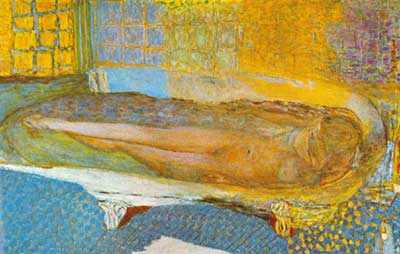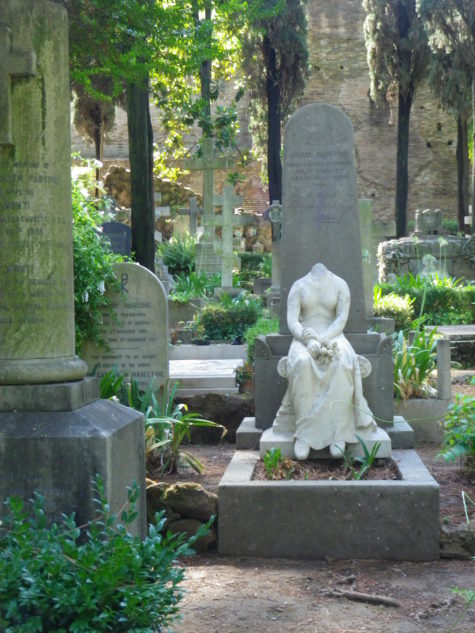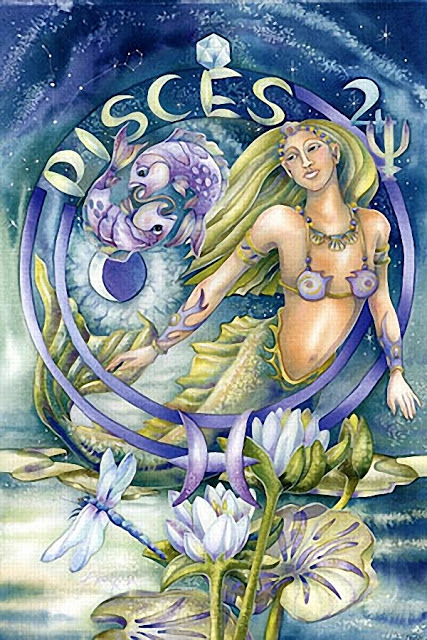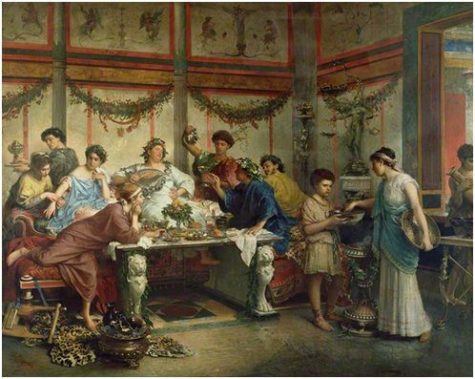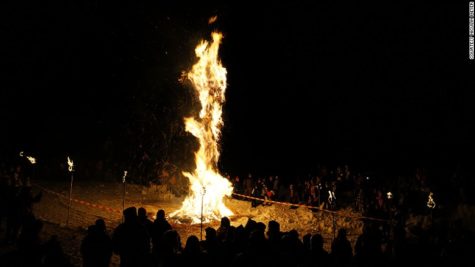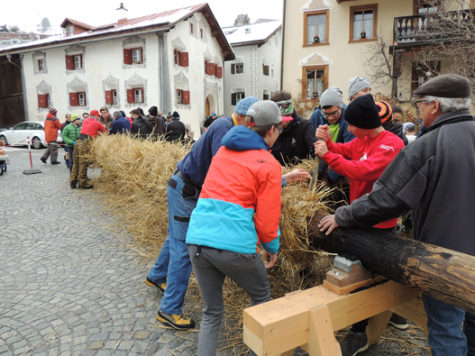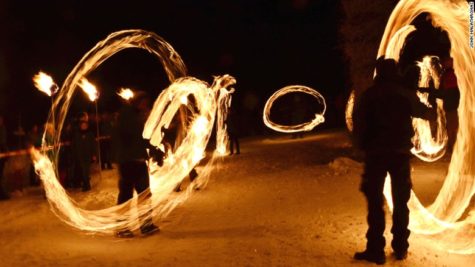Monthly Archives: February 2018
According to various sources, February 26 is Hygeia’s Day. I did not, however, find any specific rituals associated with the Goddess Hygeia. However, because bathing is so fundamental to basic hygeine, and Hygeia is the goddess of Healing and Hygeine, a healing ritual bath seems appropriate.
Healing Ritual Bath
Take a lit silver or white candle, some salt, and a healing oil (such as carnation, violet, sandalwood, or narcissus) into the bathroom. By the candle’s light run a tub of very warm water. Cast some salt into it, add a few drops of healing oil, and then step into the tub.
Relax. Feel the warm salted water sinking into your pores, through your skin, sterilizing the sick or unhappy portions of your body.
Visualize any illness or bad feelings as “black worms” leaving your body. When you feel the water teeming with them, pull the plug and let the water drain out. While it is draining, chant:
The sickness is flowing out of me.
Into the water, down to the sea.
Only when the tub is completely drained stand up. It is best to immediately splash your body with fresh water (a shower is ideal) to remove the last vestiges of the disease of sickness-laden water. Repeat as needed to speed your body’s recovery.
From: Earth Power
Termini in Roman mythology began as boundary markers between wilderness settings. The termini were rural boundary stones marking property lines between fields and neighbors. There was an annual ceremony each 23rd day of February called the Terminalia when first fruits were offered and libations of oil and honey were poured over the termini to renew the power or forces within the boundary stones between properties. Ovid presents the story as follows
When night has passed, let the god be celebrated
With customary honour, who separates the fields with his sign.
Terminus, whether a stone or a stump buried in the earth,
You have been a god since ancient times.
You are crowned from either side by two landowners,
Who bring two garlands and two cakes in offering.
An altar’s made: here the farmer’s wife herself
Brings coals from the warm hearth on a broken pot.
The old man cuts wood and piles the logs with skill,
And works at setting branches in the solid earth.
Then he nurses the first flames with dry bark,
While a boy stands by and holds the wide basket.
When he’s thrown grain three times into the fire
The little daughter offers the sliced honeycombs.
Others carry wine: part of each is offered to the flames:
The crowd, dressed in white, watch silently.
Terminus, at the boundary, is sprinkled with lamb’s blood,
And doesn’t grumble when a sucking pig is granted him.
Neighbours gather sincerely, and hold a feast,
And sing your praises, sacred Terminus:
‘You set bounds to peoples, cities, great kingdoms:
Without you every field would be disputed…
These rural termini and feast of landmarks had their state counterpart in Terminus. The story told by Ovid about the sacred boundary stone which stood, in the temple of the Capitoline Jupiter, continues:
What happened when the new Capitol was built?
The whole throng of gods yielded to Jupiter and made room:
But as the ancients tell, Terminus remained in the shrine
Where he was found, and shares the temple with great Jupiter.
Even now there’s a small hole in the temple roof,
So he can see nothing above him but stars.
Since then, Terminus, you’ve not been free to wander:
Stay there, in the place where you’ve been put,
And yield not an inch to your neighbour’s prayers …
~Ovid, Fasti Vol II
A Simple Terminalia Celebration
- Themes: Earth; Home
- Symbols: Owl; Geranium
- Presiding Goddess: Minerva
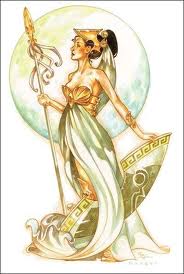 About Minerva:
About Minerva:
This Etruscan/Italic goddess blended the odd attributes of being a patroness of household tasks, including arts and crafts, and also being the patroness of protection and war. Today she joins in pre-spring festivities by helping people prepare their lands for sowing and embracing the figurative lands of our hearts, homes, and spirits with her positive energy.
To Do Today:
In ancient times, this was a day to bless one’s lands and borders. Gifts of corn, honey, and wine were given to the earth and its spirits to keep the property safe and fertile throughout the year. In modern times, this equates to a Minerva-centered house blessing.
Begin by putting on some spiritually uplifting music. Burn geranium-scented incense if possible; otherwise, any pantry spice will do. Take this into every room of your home, always moving clockwise to promote positive growing energy. As you get to each room, repeat this incantation:
Minerva, protect this sacred space
and all who live within.
by your power and my will,
the magic now begins!
Wear a geranium today to commemorate Minerva and welcome her energy into your life.
Sources:
The Feralia was the closing festival of the ancient Roman festival of Parentalia. During the Feralia, families would picnic at the tombs of their deceased family members and give libations to the dearly departed. It was believed that the shades of the dead could walk upon the earth above their graves during Feralia.
Roman citizens were instructed to bring offerings to the tombs of their dead ancestors which consisted of at least “an arrangement of wreaths, a sprinkling of grain and a bit of salt, bread soaked in wine and violets scattered about.” Additional offerings were permitted, however the dead were appeased with just the aforementioned.
Ovid tells of a time when Romans, in the midst of war, neglected Feralia, which prompted the spirits of the departed to rise from their graves in anger, howling and roaming the streets. After this event, tribute to the tombs were then made and the ghastly hauntings ceased.
“And the grave must be honoured. Appease your fathers’ Spirits, and bring little gifts to the tombs you built. Their shades ask little, piety they prefer to costly offerings: no greedy deities haunt the Stygian depths. A tile wreathed round with garlands offered is enough, A scattering of meal, and a few grains of salt, and bread soaked in wine, and loose violets: Set them on a brick left in the middle of the path…
…and hide the gods, closing those revealing temple doors, Let the altars be free of incense, the hearths without fire. Now ghostly spirits and the entombed dead wander, Now the shadow feeds on the nourishment that’s offered. But it only lasts till there are no more days in the month Than the feet that my metres possess. This day they call the Feralia because they bear [ferunt] Offerings to the dead: the last day to propitiate the shades.” – Ovid
To indicate public mourning, marriages of any kind were prohibited on the Feralia, and Ovid urged mothers, brides, and widows to refrain from lighting their wedding torches. Magistrates stopped wearing their insignia and any worship of the gods was prohibited as it “should be hidden behind closed temple doors; no incense on the altar, no fire on the hearth.”
Pisces is the twelfth sign of the zodiac. The sun enters Pisces at slightly different times each year, usually around Feb 21, sometimes the day before or the day after.
- Symbol: Two Fish swimming in opposite directions
- Element: Water
- Gemstone: Aquamarine
- Keyword: I Believe
From 365 Goddess, we have this for today:
- Themes: Foresight; Divination; Inspiration; Femininity; Psychic Abilities; Kindness; Tradition
- Symbols: A Cup; Fishes; Water
- Presiding Goddess: Saga
About Saga:
Saga, an attendant of Frigg, is a Scandinavian goddess whose name beans “seeress.” Saga is a student of the Universe, ever watchful and ever instructing us about the value of keen observation. She is directly connected with the sign of Pisces, which governs artistic expression, psychic abilities, and sensitivity towards others’ needs.
In artistic representations, Saga bears a long Viking braid, an emblem of womanhood and honor. According to the Eddas, Saga lives at Sinking Beach, a waterfall, where she offers her guests a refreshing drink of inspiration from a golden cup. Later, her name was applied to the sacred heroic texts of the Scandinavian people.
To Do Today:
Tend your sacred journals today. Write about your path, your feelings, where you see yourself going, and where you’ve been. Saga lives in those words – in your musings, memories, and thoughts – guiding them to the paper to inspire you now and in the future.
Invoke any of Saga’s attributes in your life today simply by practicing the art of observation. Really look at the world, your home, and the people around you. As you do, remember that little things count. Saga’s insight lies in the grain of sand and the wildflower as well as the stars.
More About the Sun in Pisces
The Sun is in Pisces from February 19 to March 20, depending on the year.
- Ruler: Neptune
- Season: Winter
- Modality: Mutable
- Metal: Tin
- Stone: Jade. Coral
- Color: Sea Green
- Flowers: Jonquil; Violet; Poppy
- Anatomy: Feet, Veins
- Attributes: intuitive, dreamy, artistic, humane, sympathetic, sensitive, compassionate, perceptive, tender, impressionable
As the twelfth and last sign of the zodiac, Pisces contains within itself a little experience of all the signs. This gives Pisces Suns the ability to identify with people from all walks of life—from all backgrounds—in some way. These individuals are not only changeable and adaptable, they have open minds and tremendous understanding. But Pisces itself is often misunderstood. Pisces Suns may spend a good portion of their lives yearning for understanding, and the other part in a state of divine discontent. Suffering is sometimes glamorized in the Piscean world.
Sun in Pisces people are frequently pegged as wishy-washy, but this is all a matter of opinion. What you will find behind a vaguely directionless, spacey manner is a deep person with real dreams. Their dreams are more than getting that picket fence or making it up the corporate ladder. Pisces are tuned in to a higher purpose and their dreams transcend the individual. A deep love for humanity, and compassion that knows no bounds is found with this placement of the Sun.
Pisceans are not known to be cutthroat business types, nor are they given to throwing themselves out into the world in an aggressive manner. But make no mistake about it, Pisces can be extraordinarily successful when given the chance to express themselves. The arts, marketing, music, teaching, drama, healing arts…these are all fields in which Pisces can find expression. Their imagination, attunement to humanity, and remarkable intuition endow them with enviable gifts of insight and creativity.
Pisces is a sensitive sign—both sensitive to criticism and sensitive to others’ feelings. Easily touched by human suffering, at least in theory, Pisces wouldn’t hurt a fly. They believe in people, are deeply hurt by compassionless human behavior, and have a hard time saying no. Harsh realities are avoided either through escapist behavior or self-delusion; but every now and again reality does raise its ugly head, and hits Pisces over the head. This is a sad time indeed. Pisces retreats into their own world, self-pitying and giving pep talks to themselves (“I will never trust again!”). Rest assured, though, that these periods are rather short-lived and even useful.
Pisces seems to derive energy from their (generally short) bouts of self-pity. They come back stronger, with a spring in their step, ready to face the world again, and just as, if not more, compassionate and trusting as they were before. Some might even wonder if Pisces finds pleasure in suffering. Sometimes this is the case, but most of the time, Pisces pulls a lot of creative energy from sadness. Pisces is the poet or artist with angst, although this trait is often more apparent with Moon in Pisces.
Some find Pisces’ tendency to be late for appointments, spaced out behavior, and absent-mindedness amount to irresponsibility. Pisces would be shocked to know this, however. Who me? Pisces wonders. Irresponsible? Pisces Suns absolutely care—their love knows no bounds—but their retreats from ordinary life (whether they are as simple as daydreams or actual departures) that they so seem to need every now and again are not always understandable to no-nonsense signs, such as Virgo or Aries.
Many Pisces seem almost allergic to things like shopping lists, maps, directions, and instructions, and for some brave souls, even watches — they prefer to feel their way through life than to follow some plan.
We find plenty of artists, poets, and musicians with Sun (and other personal planets) in Pisces. Piscean themes are woven throughout the songs of Billy Corgan of the Smashing Pumpkins and Kurt Cobain of Nirvana, for example.
Source: Cafe Astrology
Anthesteria, held on February 11th, celebrates the maturing of the wine and the beginning of spring. It’s an Athenian festival in honor of Dionysus, god of the grape harvest, winemaking, and wine. The celebration lasted for three days in the month of Anthesterion (from the Hellenic calendar in ancient Attica).
The word Anthesteria is associated with “flower” or the “bloom” of the grape. A. W. Verrall (Journal of Hellenic Studies, xx., 1900, p. 115) wrote that it was a feast of “revocation” where the dead were recalled to the land of the living.
In ancient Greece, Anthesteria was the name of a festival during which the participants ritually expelled the Keres, evil female spirits, from their houses.
- The First Day
On the first day, called Pithoigia (opening of the casks), wine from the newly opened casks was offered to Dionysus and everyone in the household, including servants and slaves. The home and children were adorned with spring flowers.
- The Second Day
The second day, named Choës (feast of beakers), was for visiting. People dressed for the day, some even dressed as Dionysus. They spent the day visiting friends and family as well as the local drinking clubs were drinking games were held. Some folks offered wine to deceased relatives by pouring libations on the their tombs.
For the state, however, if was a formal day with secret ceremonies in one of the sanctuaries of Dionysus. The basilissa (or basilinna), wife of the archon basileus, would marry the god of wine in a special ceremony. She was assisted by fourteen Athenian matrons, called geraerae, who the basileus chose and swore to secrecy.
Both Pithoigia and Choës were considered unlucky and defiled days that necessitated atoning with libations. From this the souls of the dead would come up from the underworld and walked the earth. People chewed on buckthorn leaves and smeared tar on their doors to protect themselves from evil.
- The Third Day
The third day, Chytri (feast of pots), was a festival of the dead. Cooked legumes were offered to Hermes, son of Zeus, and he would make the souls of the deceased depart.
Sources:
The “L’Hom Strom” festival takes place on the first Saturday in February every year the small community of Scuol in canton Graubünden, (in Switzerland close to the borders of both Austria and Italy). The “hom strom” is the famous “Straw Man of Scuol,” a large dummy.that is set alight.
On the first Saturday in February, young men crack whips to assemble the population, and the youths of Scuol, then go from farm to farm collecting straw which has been hand-threshed and especially prepared for this purpose. The straw is taken down to the village square where the thick strands of rye are then twined around a telephone pole which is almost eight meters (24 ft) long. The work must be done by noon, at which time the bundle should have reached a diameter of approximately two meters.
In the afternoon, a group of adults take the “l’hom strom” to Gurlaina and place the Hom Strom in a specially prepared hole in a field, and there set up ready for burning. The enormous effigy is carefully guarded to protect him so that pranksters – specifically the boys from the next village – cannot light him before his time!
At dusk, the people of Scuol parade through the village streets singing songs on the way to Gurlaina. As night falls, the dummy is burned, accompanied by songs to drive away the winter.When the tower clock strikes eight, the oldest boys throw balls of fire, which are rags drenched in petroleum and which have up to now illuminated the grounds, at the Hom Strom and set him aflame.
At the end of the burning ceremony attending locals sing the fourth stanza of the song Hom Strom written in the 50’s by Men Rauch, born and raised in Scuol, where a Christian adaptation is easily recognizable:
Las flommas van in ot,
portond al Segner lod,
chi’ns dosta dal malom,
eviva nos Hom Strom!!
Translation:
The flames that burn up into the sky,
give praise to the Lord,
who, in turn, protects us from evil,
long live our straw man!!…
The children and adults sing the Hom Strom song, written by a native poet. Half an hour later, the spirit of winter is consumed and everyone walks back to the village. This death by fire symbolizes the rapidly approaching end of winter.
~Info from various sources
